Leadership and Management for Service Industries Report - HNC 2018/19
VerifiedAdded on 2021/02/19
|8
|1737
|29
Report
AI Summary
This report delves into the crucial roles of leadership and management within organizations, particularly in the service sector, emphasizing their impact on achieving objectives efficiently. It examines the application of classical theories, leadership roles, and the influence of internal and external forces on management styles, using Wa-Pila as a case study. The report highlights the significance of hard and soft skills for managers and leaders in the service industry, providing examples of each. Furthermore, it includes a comparative analysis of Wa-Pila and Hilton Hotel, focusing on their management and leadership styles. The report concludes by summarizing key findings and emphasizing the importance of adaptability and effective decision-making for leaders to enhance productivity and profitability.
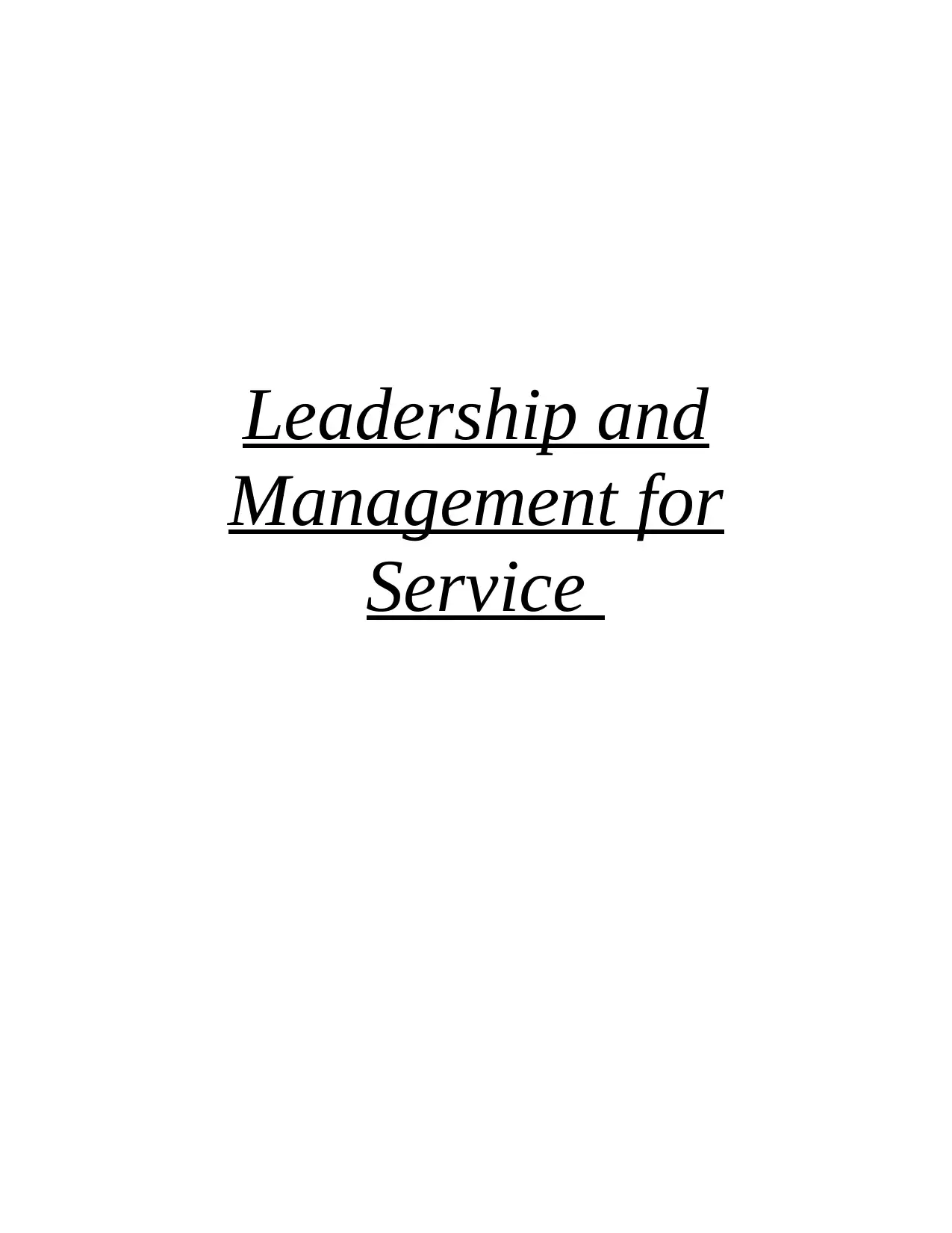
Leadership and
Management for
Service
Management for
Service
Paraphrase This Document
Need a fresh take? Get an instant paraphrase of this document with our AI Paraphraser
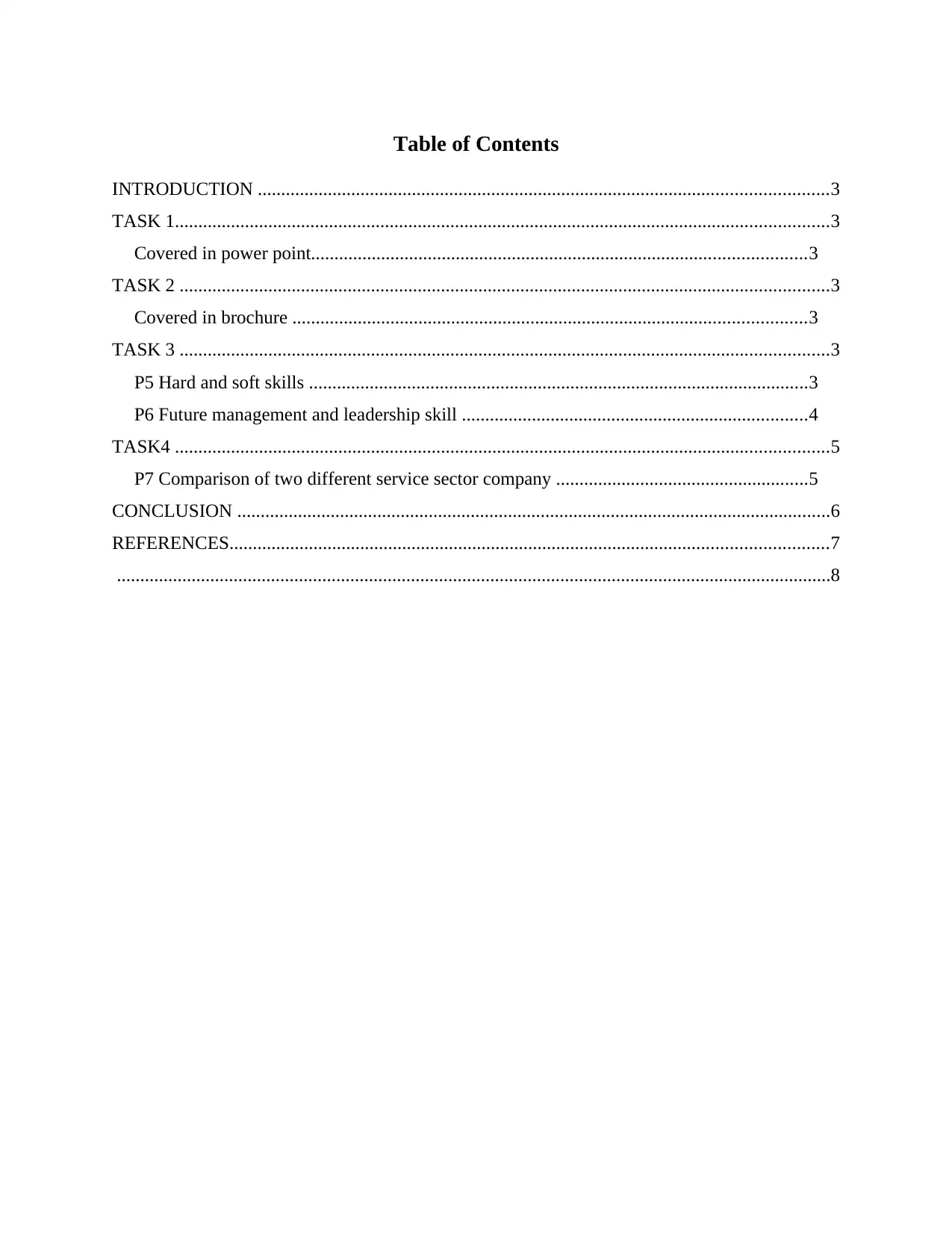
Table of Contents
INTRODUCTION ..........................................................................................................................3
TASK 1............................................................................................................................................3
Covered in power point..........................................................................................................3
TASK 2 ...........................................................................................................................................3
Covered in brochure ..............................................................................................................3
TASK 3 ...........................................................................................................................................3
P5 Hard and soft skills ...........................................................................................................3
P6 Future management and leadership skill ..........................................................................4
TASK4 ............................................................................................................................................5
P7 Comparison of two different service sector company ......................................................5
CONCLUSION ...............................................................................................................................6
REFERENCES................................................................................................................................7
.........................................................................................................................................................8
INTRODUCTION ..........................................................................................................................3
TASK 1............................................................................................................................................3
Covered in power point..........................................................................................................3
TASK 2 ...........................................................................................................................................3
Covered in brochure ..............................................................................................................3
TASK 3 ...........................................................................................................................................3
P5 Hard and soft skills ...........................................................................................................3
P6 Future management and leadership skill ..........................................................................4
TASK4 ............................................................................................................................................5
P7 Comparison of two different service sector company ......................................................5
CONCLUSION ...............................................................................................................................6
REFERENCES................................................................................................................................7
.........................................................................................................................................................8
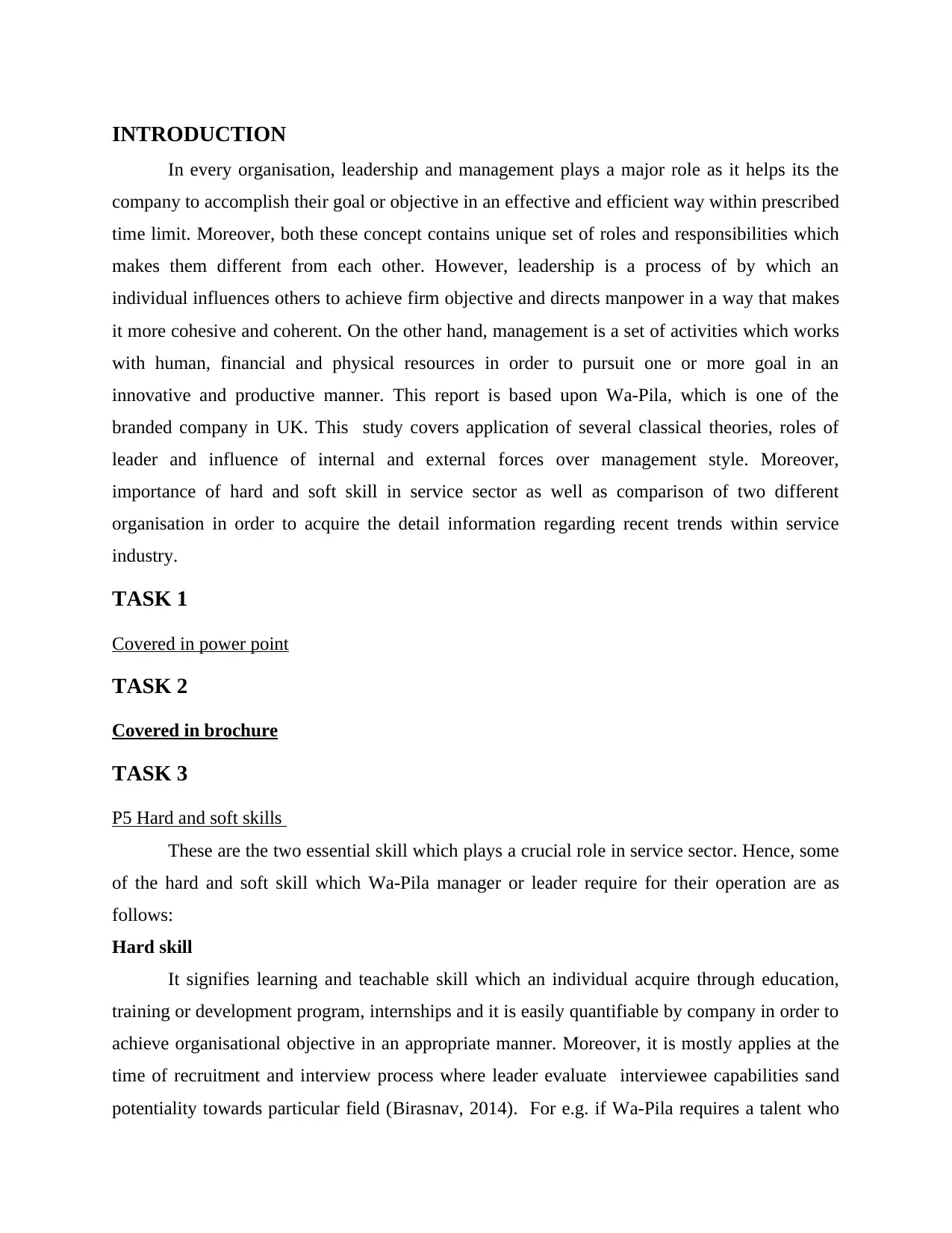
INTRODUCTION
In every organisation, leadership and management plays a major role as it helps its the
company to accomplish their goal or objective in an effective and efficient way within prescribed
time limit. Moreover, both these concept contains unique set of roles and responsibilities which
makes them different from each other. However, leadership is a process of by which an
individual influences others to achieve firm objective and directs manpower in a way that makes
it more cohesive and coherent. On the other hand, management is a set of activities which works
with human, financial and physical resources in order to pursuit one or more goal in an
innovative and productive manner. This report is based upon Wa-Pila, which is one of the
branded company in UK. This study covers application of several classical theories, roles of
leader and influence of internal and external forces over management style. Moreover,
importance of hard and soft skill in service sector as well as comparison of two different
organisation in order to acquire the detail information regarding recent trends within service
industry.
TASK 1
Covered in power point
TASK 2
Covered in brochure
TASK 3
P5 Hard and soft skills
These are the two essential skill which plays a crucial role in service sector. Hence, some
of the hard and soft skill which Wa-Pila manager or leader require for their operation are as
follows:
Hard skill
It signifies learning and teachable skill which an individual acquire through education,
training or development program, internships and it is easily quantifiable by company in order to
achieve organisational objective in an appropriate manner. Moreover, it is mostly applies at the
time of recruitment and interview process where leader evaluate interviewee capabilities sand
potentiality towards particular field (Birasnav, 2014). For e.g. if Wa-Pila requires a talent who
In every organisation, leadership and management plays a major role as it helps its the
company to accomplish their goal or objective in an effective and efficient way within prescribed
time limit. Moreover, both these concept contains unique set of roles and responsibilities which
makes them different from each other. However, leadership is a process of by which an
individual influences others to achieve firm objective and directs manpower in a way that makes
it more cohesive and coherent. On the other hand, management is a set of activities which works
with human, financial and physical resources in order to pursuit one or more goal in an
innovative and productive manner. This report is based upon Wa-Pila, which is one of the
branded company in UK. This study covers application of several classical theories, roles of
leader and influence of internal and external forces over management style. Moreover,
importance of hard and soft skill in service sector as well as comparison of two different
organisation in order to acquire the detail information regarding recent trends within service
industry.
TASK 1
Covered in power point
TASK 2
Covered in brochure
TASK 3
P5 Hard and soft skills
These are the two essential skill which plays a crucial role in service sector. Hence, some
of the hard and soft skill which Wa-Pila manager or leader require for their operation are as
follows:
Hard skill
It signifies learning and teachable skill which an individual acquire through education,
training or development program, internships and it is easily quantifiable by company in order to
achieve organisational objective in an appropriate manner. Moreover, it is mostly applies at the
time of recruitment and interview process where leader evaluate interviewee capabilities sand
potentiality towards particular field (Birasnav, 2014). For e.g. if Wa-Pila requires a talent who
⊘ This is a preview!⊘
Do you want full access?
Subscribe today to unlock all pages.

Trusted by 1+ million students worldwide
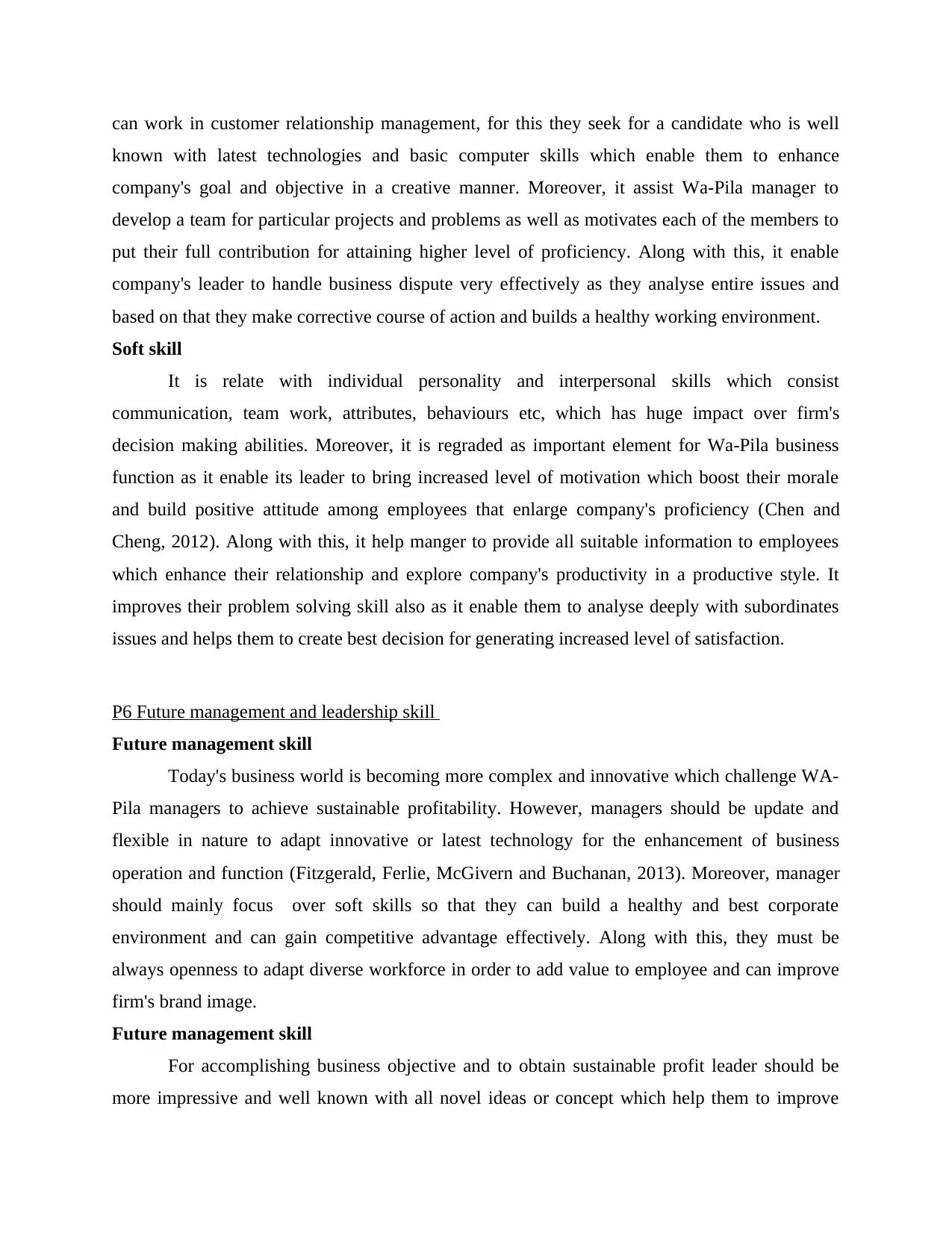
can work in customer relationship management, for this they seek for a candidate who is well
known with latest technologies and basic computer skills which enable them to enhance
company's goal and objective in a creative manner. Moreover, it assist Wa-Pila manager to
develop a team for particular projects and problems as well as motivates each of the members to
put their full contribution for attaining higher level of proficiency. Along with this, it enable
company's leader to handle business dispute very effectively as they analyse entire issues and
based on that they make corrective course of action and builds a healthy working environment.
Soft skill
It is relate with individual personality and interpersonal skills which consist
communication, team work, attributes, behaviours etc, which has huge impact over firm's
decision making abilities. Moreover, it is regraded as important element for Wa-Pila business
function as it enable its leader to bring increased level of motivation which boost their morale
and build positive attitude among employees that enlarge company's proficiency (Chen and
Cheng, 2012). Along with this, it help manger to provide all suitable information to employees
which enhance their relationship and explore company's productivity in a productive style. It
improves their problem solving skill also as it enable them to analyse deeply with subordinates
issues and helps them to create best decision for generating increased level of satisfaction.
P6 Future management and leadership skill
Future management skill
Today's business world is becoming more complex and innovative which challenge WA-
Pila managers to achieve sustainable profitability. However, managers should be update and
flexible in nature to adapt innovative or latest technology for the enhancement of business
operation and function (Fitzgerald, Ferlie, McGivern and Buchanan, 2013). Moreover, manager
should mainly focus over soft skills so that they can build a healthy and best corporate
environment and can gain competitive advantage effectively. Along with this, they must be
always openness to adapt diverse workforce in order to add value to employee and can improve
firm's brand image.
Future management skill
For accomplishing business objective and to obtain sustainable profit leader should be
more impressive and well known with all novel ideas or concept which help them to improve
known with latest technologies and basic computer skills which enable them to enhance
company's goal and objective in a creative manner. Moreover, it assist Wa-Pila manager to
develop a team for particular projects and problems as well as motivates each of the members to
put their full contribution for attaining higher level of proficiency. Along with this, it enable
company's leader to handle business dispute very effectively as they analyse entire issues and
based on that they make corrective course of action and builds a healthy working environment.
Soft skill
It is relate with individual personality and interpersonal skills which consist
communication, team work, attributes, behaviours etc, which has huge impact over firm's
decision making abilities. Moreover, it is regraded as important element for Wa-Pila business
function as it enable its leader to bring increased level of motivation which boost their morale
and build positive attitude among employees that enlarge company's proficiency (Chen and
Cheng, 2012). Along with this, it help manger to provide all suitable information to employees
which enhance their relationship and explore company's productivity in a productive style. It
improves their problem solving skill also as it enable them to analyse deeply with subordinates
issues and helps them to create best decision for generating increased level of satisfaction.
P6 Future management and leadership skill
Future management skill
Today's business world is becoming more complex and innovative which challenge WA-
Pila managers to achieve sustainable profitability. However, managers should be update and
flexible in nature to adapt innovative or latest technology for the enhancement of business
operation and function (Fitzgerald, Ferlie, McGivern and Buchanan, 2013). Moreover, manager
should mainly focus over soft skills so that they can build a healthy and best corporate
environment and can gain competitive advantage effectively. Along with this, they must be
always openness to adapt diverse workforce in order to add value to employee and can improve
firm's brand image.
Future management skill
For accomplishing business objective and to obtain sustainable profit leader should be
more impressive and well known with all novel ideas or concept which help them to improve
Paraphrase This Document
Need a fresh take? Get an instant paraphrase of this document with our AI Paraphraser
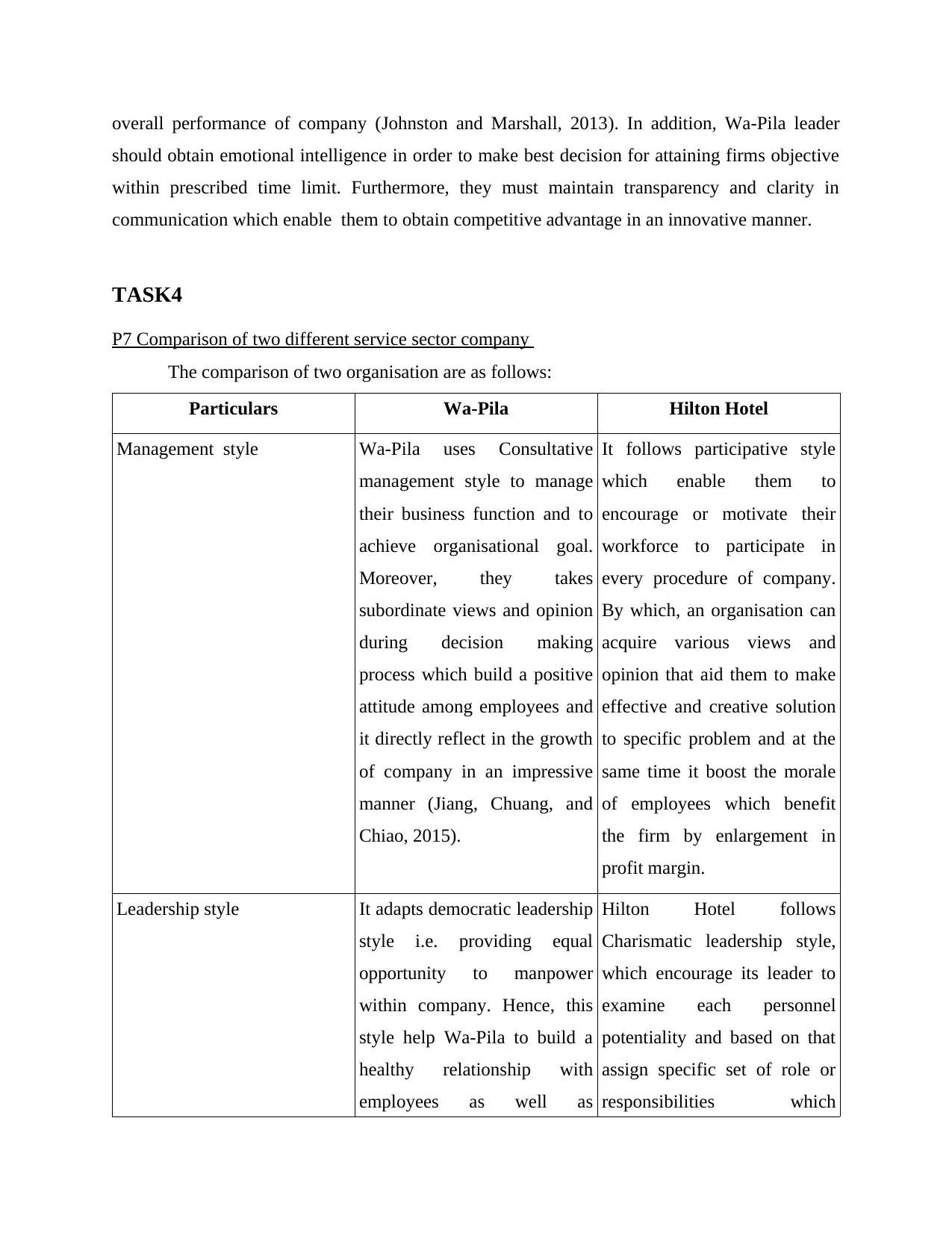
overall performance of company (Johnston and Marshall, 2013). In addition, Wa-Pila leader
should obtain emotional intelligence in order to make best decision for attaining firms objective
within prescribed time limit. Furthermore, they must maintain transparency and clarity in
communication which enable them to obtain competitive advantage in an innovative manner.
TASK4
P7 Comparison of two different service sector company
The comparison of two organisation are as follows:
Particulars Wa-Pila Hilton Hotel
Management style Wa-Pila uses Consultative
management style to manage
their business function and to
achieve organisational goal.
Moreover, they takes
subordinate views and opinion
during decision making
process which build a positive
attitude among employees and
it directly reflect in the growth
of company in an impressive
manner (Jiang, Chuang, and
Chiao, 2015).
It follows participative style
which enable them to
encourage or motivate their
workforce to participate in
every procedure of company.
By which, an organisation can
acquire various views and
opinion that aid them to make
effective and creative solution
to specific problem and at the
same time it boost the morale
of employees which benefit
the firm by enlargement in
profit margin.
Leadership style It adapts democratic leadership
style i.e. providing equal
opportunity to manpower
within company. Hence, this
style help Wa-Pila to build a
healthy relationship with
employees as well as
Hilton Hotel follows
Charismatic leadership style,
which encourage its leader to
examine each personnel
potentiality and based on that
assign specific set of role or
responsibilities which
should obtain emotional intelligence in order to make best decision for attaining firms objective
within prescribed time limit. Furthermore, they must maintain transparency and clarity in
communication which enable them to obtain competitive advantage in an innovative manner.
TASK4
P7 Comparison of two different service sector company
The comparison of two organisation are as follows:
Particulars Wa-Pila Hilton Hotel
Management style Wa-Pila uses Consultative
management style to manage
their business function and to
achieve organisational goal.
Moreover, they takes
subordinate views and opinion
during decision making
process which build a positive
attitude among employees and
it directly reflect in the growth
of company in an impressive
manner (Jiang, Chuang, and
Chiao, 2015).
It follows participative style
which enable them to
encourage or motivate their
workforce to participate in
every procedure of company.
By which, an organisation can
acquire various views and
opinion that aid them to make
effective and creative solution
to specific problem and at the
same time it boost the morale
of employees which benefit
the firm by enlargement in
profit margin.
Leadership style It adapts democratic leadership
style i.e. providing equal
opportunity to manpower
within company. Hence, this
style help Wa-Pila to build a
healthy relationship with
employees as well as
Hilton Hotel follows
Charismatic leadership style,
which encourage its leader to
examine each personnel
potentiality and based on that
assign specific set of role or
responsibilities which
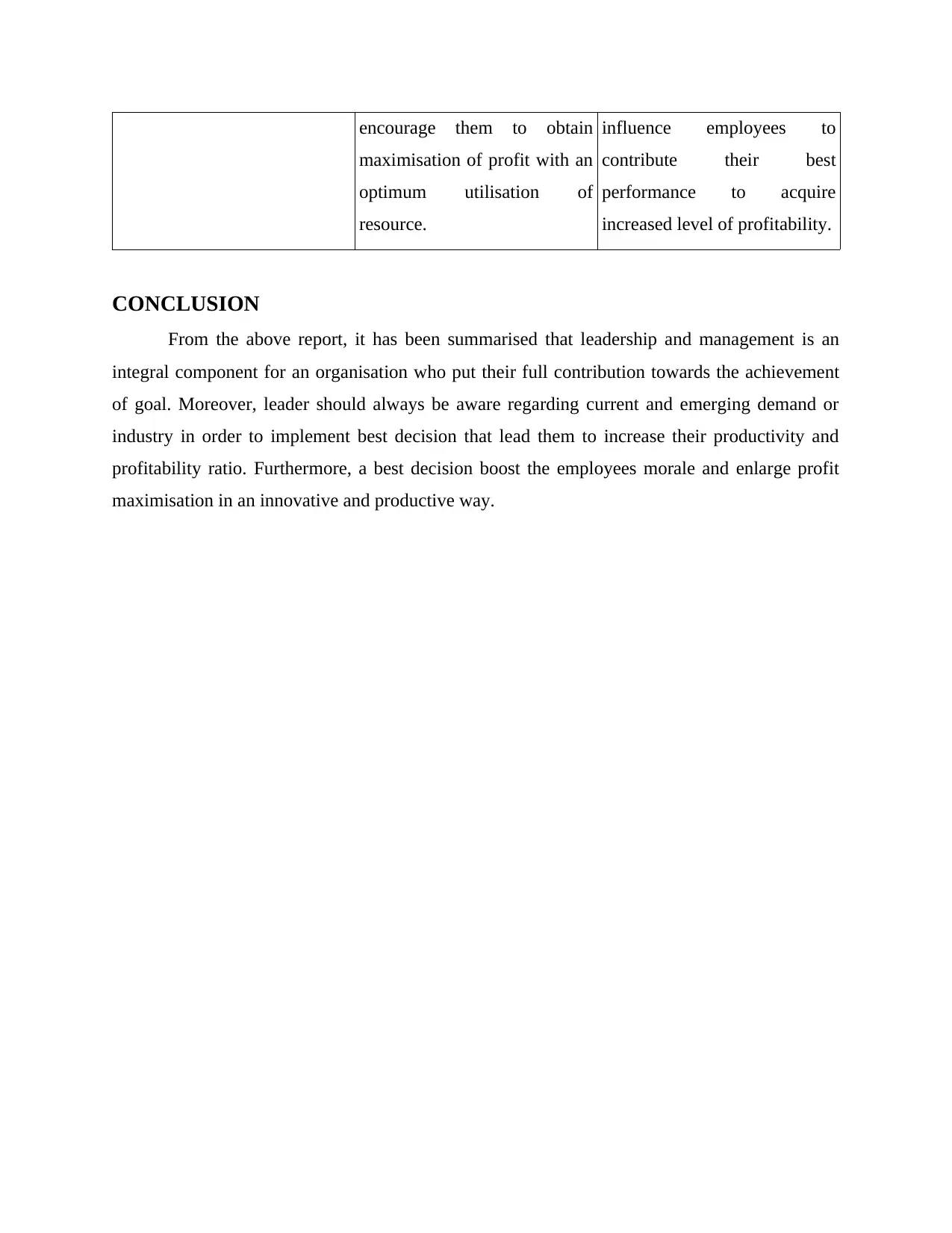
encourage them to obtain
maximisation of profit with an
optimum utilisation of
resource.
influence employees to
contribute their best
performance to acquire
increased level of profitability.
CONCLUSION
From the above report, it has been summarised that leadership and management is an
integral component for an organisation who put their full contribution towards the achievement
of goal. Moreover, leader should always be aware regarding current and emerging demand or
industry in order to implement best decision that lead them to increase their productivity and
profitability ratio. Furthermore, a best decision boost the employees morale and enlarge profit
maximisation in an innovative and productive way.
maximisation of profit with an
optimum utilisation of
resource.
influence employees to
contribute their best
performance to acquire
increased level of profitability.
CONCLUSION
From the above report, it has been summarised that leadership and management is an
integral component for an organisation who put their full contribution towards the achievement
of goal. Moreover, leader should always be aware regarding current and emerging demand or
industry in order to implement best decision that lead them to increase their productivity and
profitability ratio. Furthermore, a best decision boost the employees morale and enlarge profit
maximisation in an innovative and productive way.
⊘ This is a preview!⊘
Do you want full access?
Subscribe today to unlock all pages.

Trusted by 1+ million students worldwide
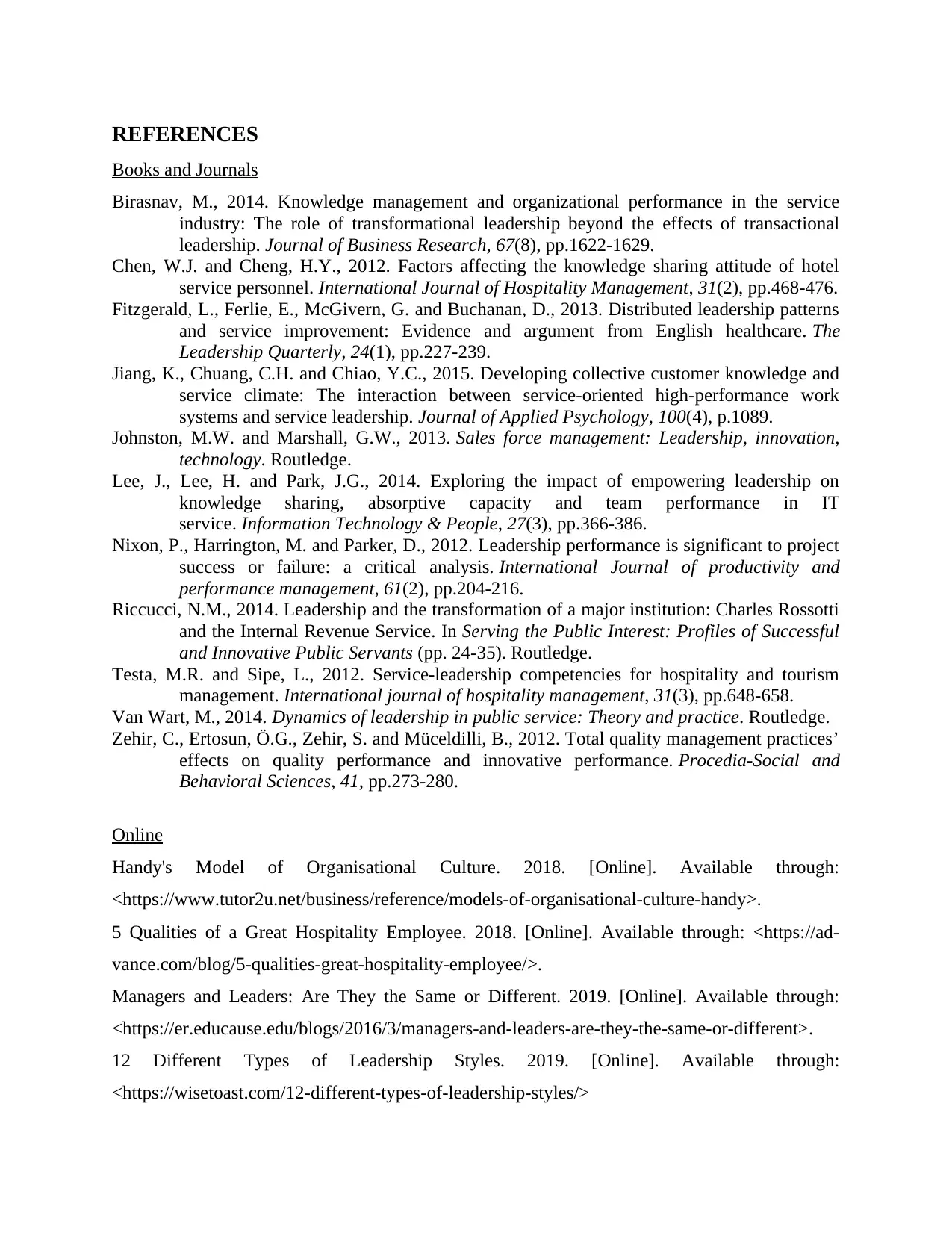
REFERENCES
Books and Journals
Birasnav, M., 2014. Knowledge management and organizational performance in the service
industry: The role of transformational leadership beyond the effects of transactional
leadership. Journal of Business Research, 67(8), pp.1622-1629.
Chen, W.J. and Cheng, H.Y., 2012. Factors affecting the knowledge sharing attitude of hotel
service personnel. International Journal of Hospitality Management, 31(2), pp.468-476.
Fitzgerald, L., Ferlie, E., McGivern, G. and Buchanan, D., 2013. Distributed leadership patterns
and service improvement: Evidence and argument from English healthcare. The
Leadership Quarterly, 24(1), pp.227-239.
Jiang, K., Chuang, C.H. and Chiao, Y.C., 2015. Developing collective customer knowledge and
service climate: The interaction between service-oriented high-performance work
systems and service leadership. Journal of Applied Psychology, 100(4), p.1089.
Johnston, M.W. and Marshall, G.W., 2013. Sales force management: Leadership, innovation,
technology. Routledge.
Lee, J., Lee, H. and Park, J.G., 2014. Exploring the impact of empowering leadership on
knowledge sharing, absorptive capacity and team performance in IT
service. Information Technology & People, 27(3), pp.366-386.
Nixon, P., Harrington, M. and Parker, D., 2012. Leadership performance is significant to project
success or failure: a critical analysis. International Journal of productivity and
performance management, 61(2), pp.204-216.
Riccucci, N.M., 2014. Leadership and the transformation of a major institution: Charles Rossotti
and the Internal Revenue Service. In Serving the Public Interest: Profiles of Successful
and Innovative Public Servants (pp. 24-35). Routledge.
Testa, M.R. and Sipe, L., 2012. Service-leadership competencies for hospitality and tourism
management. International journal of hospitality management, 31(3), pp.648-658.
Van Wart, M., 2014. Dynamics of leadership in public service: Theory and practice. Routledge.
Zehir, C., Ertosun, Ö.G., Zehir, S. and Müceldilli, B., 2012. Total quality management practices’
effects on quality performance and innovative performance. Procedia-Social and
Behavioral Sciences, 41, pp.273-280.
Online
Handy's Model of Organisational Culture. 2018. [Online]. Available through:
<https://www.tutor2u.net/business/reference/models-of-organisational-culture-handy>.
5 Qualities of a Great Hospitality Employee. 2018. [Online]. Available through: <https://ad-
vance.com/blog/5-qualities-great-hospitality-employee/>.
Managers and Leaders: Are They the Same or Different. 2019. [Online]. Available through:
<https://er.educause.edu/blogs/2016/3/managers-and-leaders-are-they-the-same-or-different>.
12 Different Types of Leadership Styles. 2019. [Online]. Available through:
<https://wisetoast.com/12-different-types-of-leadership-styles/>
Books and Journals
Birasnav, M., 2014. Knowledge management and organizational performance in the service
industry: The role of transformational leadership beyond the effects of transactional
leadership. Journal of Business Research, 67(8), pp.1622-1629.
Chen, W.J. and Cheng, H.Y., 2012. Factors affecting the knowledge sharing attitude of hotel
service personnel. International Journal of Hospitality Management, 31(2), pp.468-476.
Fitzgerald, L., Ferlie, E., McGivern, G. and Buchanan, D., 2013. Distributed leadership patterns
and service improvement: Evidence and argument from English healthcare. The
Leadership Quarterly, 24(1), pp.227-239.
Jiang, K., Chuang, C.H. and Chiao, Y.C., 2015. Developing collective customer knowledge and
service climate: The interaction between service-oriented high-performance work
systems and service leadership. Journal of Applied Psychology, 100(4), p.1089.
Johnston, M.W. and Marshall, G.W., 2013. Sales force management: Leadership, innovation,
technology. Routledge.
Lee, J., Lee, H. and Park, J.G., 2014. Exploring the impact of empowering leadership on
knowledge sharing, absorptive capacity and team performance in IT
service. Information Technology & People, 27(3), pp.366-386.
Nixon, P., Harrington, M. and Parker, D., 2012. Leadership performance is significant to project
success or failure: a critical analysis. International Journal of productivity and
performance management, 61(2), pp.204-216.
Riccucci, N.M., 2014. Leadership and the transformation of a major institution: Charles Rossotti
and the Internal Revenue Service. In Serving the Public Interest: Profiles of Successful
and Innovative Public Servants (pp. 24-35). Routledge.
Testa, M.R. and Sipe, L., 2012. Service-leadership competencies for hospitality and tourism
management. International journal of hospitality management, 31(3), pp.648-658.
Van Wart, M., 2014. Dynamics of leadership in public service: Theory and practice. Routledge.
Zehir, C., Ertosun, Ö.G., Zehir, S. and Müceldilli, B., 2012. Total quality management practices’
effects on quality performance and innovative performance. Procedia-Social and
Behavioral Sciences, 41, pp.273-280.
Online
Handy's Model of Organisational Culture. 2018. [Online]. Available through:
<https://www.tutor2u.net/business/reference/models-of-organisational-culture-handy>.
5 Qualities of a Great Hospitality Employee. 2018. [Online]. Available through: <https://ad-
vance.com/blog/5-qualities-great-hospitality-employee/>.
Managers and Leaders: Are They the Same or Different. 2019. [Online]. Available through:
<https://er.educause.edu/blogs/2016/3/managers-and-leaders-are-they-the-same-or-different>.
12 Different Types of Leadership Styles. 2019. [Online]. Available through:
<https://wisetoast.com/12-different-types-of-leadership-styles/>
Paraphrase This Document
Need a fresh take? Get an instant paraphrase of this document with our AI Paraphraser

1 out of 8
Related Documents
Your All-in-One AI-Powered Toolkit for Academic Success.
+13062052269
info@desklib.com
Available 24*7 on WhatsApp / Email
![[object Object]](/_next/static/media/star-bottom.7253800d.svg)
Unlock your academic potential
Copyright © 2020–2025 A2Z Services. All Rights Reserved. Developed and managed by ZUCOL.





